Outbreak of World War II and its Impact in Colonies | History - Second World War: Causes | 12th History : Chapter 14 : Outbreak of World War II and its Impact in Colonies
Chapter: 12th History : Chapter 14 : Outbreak of World War II and its Impact in Colonies
Second World War: Causes
Second World War: Causes
In the beginning of the war, with Great Britain and
France opposing Germany and with Italy remaining temporarily neutral and later
joining Germany, the line-up of the two sides in both world wars was similar.
The notable difference was that Japan aligned with Germany instead of with the
Western powers. Russia and the USA did not enter the conflict until two years
after it began. The methods of warfare had changed during the Second World War.
Trench warfare gave way to aerial bombing. No distinction was made between
combatants and civilians in the Second World War. Casualties in the Second
World War were therefore heavy.
Let us first trace the circumstances that led to
the outbreak of the War.
(a) The Unjust Nature of the Peace Treaty
The terms imposed upon Germany at the end of First
World War were harsh. Stripped off its colonies, the size of the German army
was drastically reduced. Germany was forced to cede Alsace and Lorraine to
France and to agree to the temporary occupation by French troops of the Saar
valley. Germany was also compelled to hand over to Poland large parts of the
industrial area of Silesia. Further Germany was to pay an impossible sum (6600
million pounds) in reparation. These terms gave rise to a strong feeling of
injustice in Germany and had much do with the subsequent success of the Nazi
Politics. Italy felt aggrieved as Dalmatia, claimed to be predominantly
Italian, was incorporated in the new state of Yugoslavia. Reduced to the status
of a small republic, Austria was not allowed to unite with Germany as the
combination would be a threat to France.
(b) Failure of the League of Nations
The League of Nations, envisaged as an
international body to avert another world war, turned out to be an alliance of
the victors against the vanquished. The seeds for another war were sowed ever
since the Treaty of Versailles was signed.
From 1918 to 1933 a series of conferences were held
to eliminate threats of war. In 1925, representatives of the chief European
powers met at Locarno, a Swiss town, where Germany and France agreed to respect
the Rhine frontiers, as established in the Versailles treaty. The next
agreement widely appreciated was the Kellogg– Briand Pact of 1928. Though the
US did not become a member of the League of Nations, it participated in this
meet. The outcome of this pact was the pledge of all nations of the world to
renounce war as “an instrument of national policy”. But the League of Nations
was not strong enough to enforce these agreements when some countries defied
them.
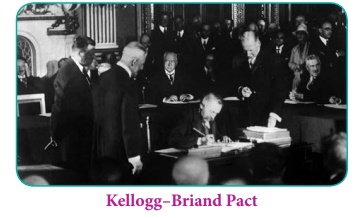
When Hitler came to power in 1933, a Disarmament
Conference was organised by the League of Nations at Geneva. The issue was the
German rearmament plan on a par with France. The French refused to agree to
this proposal, while Britain was willing to concede Germany’s demand. Hitler’s
response to French refusal was withdrawal of Germany from the conference and
from the League of Nations. A plebiscite in Germany showed enormous support in
favour of Hitler’s step. Encouraged, in March 1935, Hitler announced Germany’s
intention of building up an army by conscription to over half a million men.
This was the first breach of the Treaty of Versailles. The League of Nations
attended by Britain, France and Italy condemned Germany’s action but took no
further steps. Britain even went to the extent of negotiating a naval
agreement. According to this agreement, Germany could build up to 35 per cent
of Britain’s naval strength.

Italy invaded Ethiopia in 1935. Emperor Haile
Selassie of Ethiopia appealed to the League of Nations, but received no help.
(c) Economic Depression of 1930s
The most important economic cause of World War II
was the Great Depression. The Depression intensified economic nationalism. Hit
by the problems of unemployment and business stagnation, governments resorted
to high tariffs to preserve the home market for consumption of their home
products. This resulted in an expansionist policy leading to the conquest of
neighboring territories as a means of solving economic problems. Japan took the
lead. In 1931 it reacted to the global economic crisis by seizing the Chinese
northern region of Manchuria. In the face of decline of Japanese exports of raw
silk and cotton cloth, Japanese militarists came up with this idea so that
Manchuria could be a market.
(d) Aspirations of German Big Business and Grievances of German Patriots
Britain, France, the US and the USSR each
controlled vast areas as colonies across the world. Germany, the most powerful
industrial country in continental Europe, had no colonies. This prompted German
big business to campaign vigorously to break the restraints imposed by the
Treaty of Versailles. It wanted to recover German territory lost to Poland,
absorb the German-speaking Austrian state and Czech border land, the
Sudetenland. Under Nazi rule there was convergence between the requirements of
big business and Nazi ideology.
Powers like Great Britain, the United States,
France and Russia had their empire extending over one fourth of land area of
the earth. Germany, Italy and Japan seemed poor by comparison. German patriots
openly articulated their grievance by stating that the average German citizen
had only .004 of square mile of living space at his disposal, whereas the
average Briton could draw upon the wealth and economic opportunities of almost
three square miles of imperial territory.
(e) Mussolini’s Expansionist Policy
Mussolini’s Italy sought to expand its colonial
empire by grabbing Ethiopia to add to its colonial possessions such as
Somaliland, Eritrea and Libya. It looked for an opportunity to seize Albania
from Yugoslavia.The establishment of an economy based on military state
capitalism encouraged the drive to armed expansion. The arms industries needed
raw materials and the only way to obtain the resources required was to grab
extra territory.
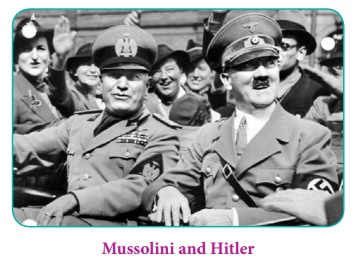
Britain and France condemned Mussolini’s invasion
of Ethiopia and this helped Hitler to establish close relationship with Italy.
This was the beginning of Rome–Berlin Axis
(f) Japan’s Imperial Policy
The German approach was emulated in East Asia by
Japan. It had already taken Taiwan and Korea as colonies, and controlled
Manchuria. The government that came up after a military coup in Japan (1936)
began to cast its covetous eye over Dutch East Indies, the British colonies in
Malaya and Singapore, the French colonies in Indochina and the US-controlled
Philippines.
(g) Responsibility of Hitler for the War
(i) Incorporation of Saar into Germany
Under the terms of the Treaty of Versailles, a
plebiscite was to be held in the Saar in January 1935. The people were to
decide whether they wished to join Germany or France, or remain under League of
Nations’ control. Ninety per cent voted for a return to Germany. In March 1935
the Saar was incorporated into Germany. This was a morale booster for Hitler.
(ii) Annexation of Rhineland
In 1936 Hitler flouted the peace settlement by
sending troops to occupy Rhineland, the area of Germany demilitarised by the
Treaty of Versailles. If the French had resisted, the Germans would have
withdrawn. The French army at that time was stronger than the German, but
economic distress caused by the Great Depression and political instability
leading to the resignation of Prime Minister Edouard Daladier rendered France
incapable of resisting the breach of the Treaty of Versailles by Germany.

(iii) Forcible Merger of Austria with Germany
Hitler, an Austrian by birth, had always wanted
Austria to be part of Germany. In February 1938, Hitler summoned the Austrian
Chancellor Schuschnigg to Berchtesgaden, a mountain town in the Bavarian Alps,
for a discussion. The Austrian Chancellor was given a Hobson’s choice – either
to legalise Nazi Party in Austria and integrate Austria’s economy with that of
Germany or face a German invasion. Austria has lost the support of Italy with
the formation of the Rome–Berlin Axis. Schuschnigg was therefore left with no
choice but to choose the first option. At the instance of Hitler, the Austrian
Chancellor cancelled the proposed plebiscite in Austria and formed a Nazi
government there. Thereupon the German army entered Vienna to take control of
the country.
(iv) Occupation of Sudetenland
Encouraged by the lack of resistance from major
European powers, Hitler turned his attention towards Czechoslovakia. In June
1938, Hitler sent directions to his army about his intention of invading Sudetenland.
A systematic Nazi propaganda that their German subjects were being subjected to
harsh treatment in Sudetenland was launched. The British Prime Minister,
Neville Chamberlain, after consulting the French and the Czechs, eventually
agreed to cede to Germany all territories where more than half the inhabitants
were German. But to the warmonger Hitler, this proposition was unacceptable. He
was keen to avoid any plebiscite in this matter. So he wanted his army to
occupy Sudetenland before such a plebiscite could take place.
Munich Agreement
The mood in London was in favour of a war against
Hitler. But Chamberlain and his counterpart in France were bent on buying peace
at any cost – a policy called ‘appeasement’. A conference was held at Munich
where the British, French, German and Italian premiers agreed that the German
army should occupy the Sudetenland, as demanded by Hitler, on 1 October and
that parts of Czechoslovakia should go to Poland and Hungary.
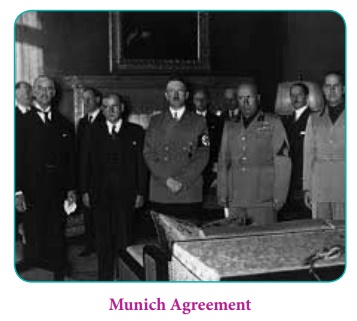
(v) Aggression against Czechoslovakia
The Czechs felt betrayed. The new frontiers of
Czechoslovakia had been guaranteed by the four powers at the Munich Conference.
Chamberlain claimed that the deal had averted another massive European war. But
using the conflict between the Slovaks and the Czechs as an excuse, Hitler sent
German forces to occupy the conflict zone.
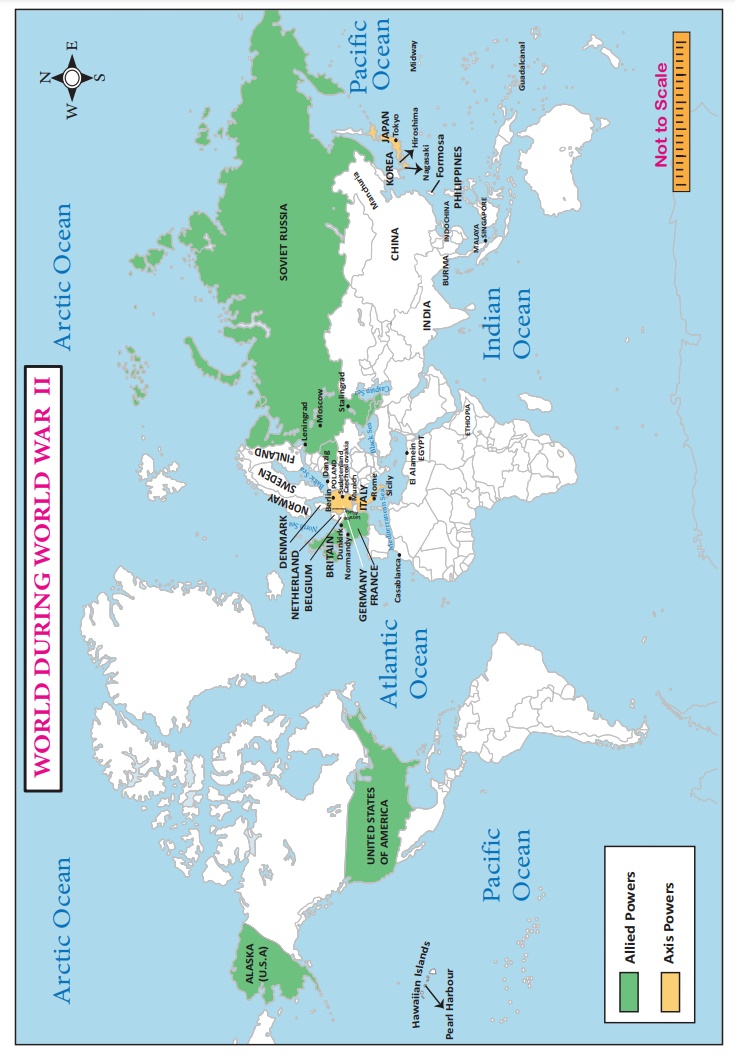
Nazi–Soviet Pact
The guarantees that Britain and France had given
Poland were considered weak without Russia’s help. During the early summer of
1939, Britain and France negotiated with Russia. But partly because of mutual
distrust and partly because Russia was not prepared for a war against Germany,
no progress could be made. Russians preferred peace and guarantee for their
territories. As Germany offered both, in August 1939 the Nazi–Soviet
(Non-aggression) Pact was signed in the Kremlin. The secret clauses in the pact
were: Eastern Europe was to be demarcated into German and Russian spheres of
influence and Poland was to be divided.
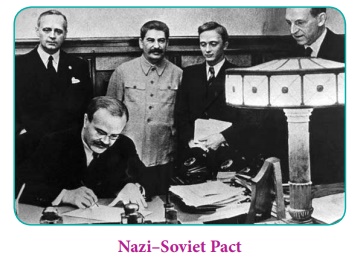
(vi) Invasion of Poland and Outbreak of War
In
order to carry out Hitler’s larger plan of conquering the whole of
Europe,Germany invaded Poland on 1 September 1939 on the ground thatPoland had
been planning with its allies, Great Britain and France, to encircle and
dismember Germany and that Poles were persecuting ethnic Germans. In two days
Britain gave the ultimatum: unless German troops were withdrawn from Poland,
Britain and Germany would be at war. The ultimatum was ignored and the
Second World War began.
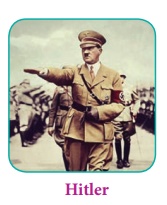
Stages of War
War in Europe
In the first few years of the War the German army
seemed unstoppable. Poland was easily defeated within two weeks and divided
between Germany and the Soviet Union in a second agreement signed in Moscow in
September 1939. In April 1940 Germany occupied Norway. With this annexation,
Hitler ensured the protection of Germany’s supply of iron ore from Sweden apart
from obtaining naval and air bases with which to strike at Britain. On 10 May
1940 Germany invaded the Netherlands, Luxembourg, Belgium and France, launching
its blitzkrieg (the lightning
strike).
In six weeks all were defeated and British forces
were expelled from continental Europe. About 198,000 British troops as well as
140,000 Allied troops, mainly French, had to be taken to the beaches in Dunkirk
and evacuated in boats and small ships under heavy fire (May-June 1940). The
French soldiers evacuated from Dunkirk formed the nucleus of the Free French
army under General de Gaulle, who ran the French government in exile to fight
the Fascists. But for the Dunkirk evacuation, Britain would have found it
difficult to regroup.
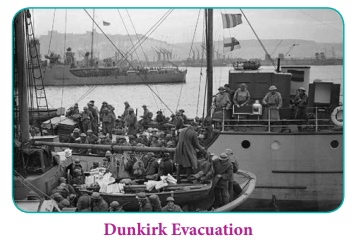
Emboldened by Hitler’s success, Italy joined
Germany and invaded France in June and Egypt in September 1940. Around this
time Japan also joined the Axis powers. Hitler expected Britain to sue for
peace. But Prime Minister Churchill, who replaced Chamberlain, refused to
compromise. The German air force, in an attempt to force a surrender, began to
attack specific targets, especially the ports, airfields and industrial
installations. In September 1940, London was bombed – an operation known as the
Blitz. By October 1940, night bombing
raids on London and other industrial cities became routine. However, the German
strategy failed because with the aid of the newly developed device ‘radar’ for
detecting aircraft while still at a distance, the fighter planes of the Royal
Air Force (Spitfires and Hurricanes) inflicted severe losses on the German
bombers. In the Battle of Britain (in the air between July and October 1940),
Hitler suffered his first defeat. But the U-Boat [a German Submarine] war in
the Atlantic was disrupting British trade.
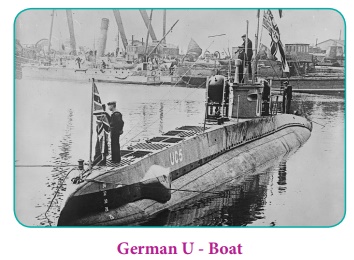
In November 1940, a decision taken by Germany to
invade Russia was deferred due to the campaign in the Balkans (April) against
Yugoslavia and Greece. On 22 June 1941 the invasion of Soviet Union commenced.
After a series of victories, German forces approached Leningrad and Moscow. By
1941 Hitler’s empire in Europe had reached its zenith.
German rule everywhere was repressive, brutal and
exploitative. More than seven million Europeans, from France to Russia, were
taken as forced labour to Germany. One third of Germanys’ war costs was met by
tribute extracted from occupied Europe. Nazi racism was directed against the
Jews, communists and gypsies. Jews were imprisoned in concentration camps, and
about six million Jews were murdered in a state-sponsored genocide using
industrial methods of extermination (called the Holocaust).
The War in Asia and the Pacific
German victories in the Soviet Union prompted
Japanese leaders to go on an offensive in Southeast Asia and the Pacific. The
decision for war with the US was taken in November 1941. On 7 December Japanese
aircraft attacked the Pearl Harbour naval base in the Hawaiian islands,
inflicting severe damages to the US Pacific Fleet. Japan then occupied English
colonial territories in Burma, Malaya, Singapore (where the British beat a
shameful retreat, leaving the population under the mercy of the Japanese) and
the Dutch possession of East Indies.
Pearl Harbour Incident and its Fallout
The Japanese attack on Pearl Harbour, instead of
crushing the morale of the American people, galvanised them into action. Until
then kept out of the war due to American public opinion, the United States
declared war on Japan, thus making it an absolute world war. Britain and China
joined the US. Under the Lend-Lease system, President Roosevelt had already
committed the US government to aid the opponents of Fascism, in the context of
Italy and Japan joining Germany. The direct involvement of the US greatly
expanded the resources of the Allies as America brought more vehicles, ships
and aircrafts than all the other fighting countries put together. In August
1942, US forces commanded by MacArthur began to play a prominent role in the
Pacific. The naval battle planned by Admiral Yamamoto resulted in a major
Japanese defeat.

The US navy defeated the Japanese navy in the
Battle of Midway (4–7 June 1942), which turned the tide in favour of the
Allies. The Battle of Guadalcanal in the Solomon Islands was a combined
offensive of the army and the navy, and lasted for several months (7 August
1942–9 February 1943). This battle too ended in a crushing defeat for the
Japanese. After this, the American forces were able to re-take the Philippines
and gradually the Japanese were pushed out of most of their conquered
territories. In 1944, the combined British and Indian armies were able to
repulse the Japanese who attempted to invade the north-east of India. Then,
along with the Chinese, they pushed the Japanese out of Burma, and took over
Malaya and Singapore.
The Battle of Stalingrad, 1942
The German strategy of lightning strikes was
initially successful in Soviet Russia. But the German army did not succeed in
reaching Moscow. It faced the bloodiest battles in world history at Stalingrad.
Hitler thought Stalingrad would be a prize catch, as it was a large industrial
city producing armaments and tractors. He was also aiming for the rich oil
fields of the Caucasus. In addition, seizing the city that bore the name of the
Soviet leader Joseph Stalin would add further glory to the image of Hitler. But
even after it became clear that the German Army could not hold Stalingrad,
Hitler refused to allow a strategic withdrawal. He was scared that the
strategic withdrawal from Stalingrad would greatly dent Nazi prestige. Thus,
Hitler condemned his best army to cold, starvation and death even as the Soviet
army fired by a nationalist spirit fought without respite. The great Soviet
counter-offensive in the summer (1942) turned the tide in favour of Soviet
Union. Many military historians have argued that the fate of the war was
decided in Stalingrad.
The victory at this “Great Patriotic War” set the
Red Army on course to storm Berlin. Along with the Allied forces of Britain,
France and America, Soviets defeated the German army, effectively ending World
War II in Europe.
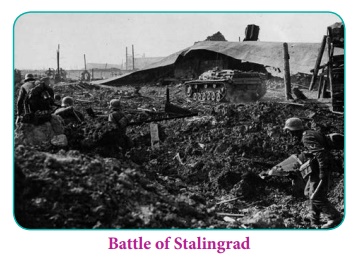
According to one estimate, the total number of
Russians dead touched 20 million (13 million soldiers and seven million
civilians).
Fall of Mussolini
At the end of 1942, the Allied cause was saved when
German forces suffered their first reverses at El Alamein in north Africa. The
Battle of El Alamein, fought between the German–Italian army commanded in the
field by Erwin Rommel and the British forces, in the deserts of North Africa,
led to a German Surrender in May 1943. The Allied forces then invaded Sicily.
The same king, Victor Immanuel III, who had handed power to Mussolini in 1922
replaced him with General Badoglio and sued for peace. Mussolini was kept under
house arrest. The General Badoglio government of Italy formally signed a
surrender in Sicily on 3 September 1943.
During 1943 there were two high level conferences
among the Allies. In January Churchill and Roosevelt met at Casablanca. Here
they decided to postpone the invasion of France, which for over four years
(1940–44) was literally a German province, until the next year. (The Germans
who had occupied France possessed sixty army divisions.) The second conference
was at Teheran in Persia in which Stalin was also present. Based on the
strategy planned, the Anglo–American invasion of France was fixed for 6 June
1944. The supreme commander of the Allied forces was the American General
Eisenhower.
Invasion of Anglo–American Forces and Bombing of Dresden
The Allied forces under the command of Eisenhower
invaded Normandy in France. Normandy was cleared of German forces and on 25
August 1944 Paris was liberated. By the beginning of September the Allies had
gained control of the whole of the country, and also occupied Belgium. The
Allied bombing of Germany (February 13–15, 1945) almost completely destroyed
the German city of Dresden. The raids became a symbol of the “terror bombing”
campaign against Germany. During this period, altogether 600,000 German
citizens were killed. Slowly, the German army was forced back. But the Germans
resisted and the war continued for another year.
In 1945 a final assault on Germany brought Western
and Soviet forces face to face across central Germany. On April 30, 1945 Soviet
forces neared Hitler’s command bunker in central Berlin. Hitler committed
suicide. Berlin fell into the hands of Soviets on 2 May. The Soviet army had
already captured much of Eastern Europe and Poland.
Dropping of Atomic Bombs and the End of World War II
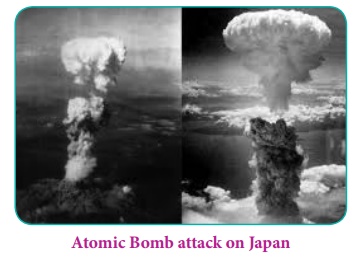
Despite the defeat of Germany, the Japanese
generals refused to surrender. Finally, the US on 6 August 1945 dropped an atomic
bomb on Hiroshima and three days later (9 August) on Nagasaki. In the race to
develop the atomic bomb, the US had overtaken Germany. Japan surrendered
immediately, thereby bringing an end to World War II. Between 60,000–80,000
people were killed instantly when the bomb was dropped over Hiroshima, and an
estimated 140,000 died from its effects before the end of the year. The death
toll increased to over 200,000 in subsequent decades, as people died of cancer
(leukemia) and other diseases linked to dangerous radiation.
Historians differ in their interpretations of the
causes of the war. Some attribute it to the Treaty of Versailles which was
harsh and vindictive. So they justify Germany’s desire to change the terms of
the treaty. There are others who blame the policy of appeasement followed by
Britain and France. A few point out the failure of Britain and France to reach
an agreement with the Soviet Union. They not only distrusted the Soviet Union
but did not respond to proposals for collective security put forward from 1934
onward. But most historians hold Germany and Hitler responsible. They assert
that it was the unscrupulous, ruthless and aggressive policies based on a
belligerent nationalism and an ideology of racial (Aryan) purity, plunged the
world into six years of devastating warfare. ‘The Second World War was Hitler’s
war. He planned it, began it and ultimately lost it.’
Peace Making
The Atlantic Charter, a statement issued by
President Roosevelt and Prime Minister Churchill, formed the basis of the
settlement of peace. Its essential principles were as follows:
1. No territorial changes without the consent of
the people concerned.
2. The right of the people to choose the form of
their government.
3. All states to enjoy on equal terms access to the
trade and raw materials of the world.
4. Freedom to travel across the sea without
hindrance
5. Disarmament of all nations that threaten
aggression.
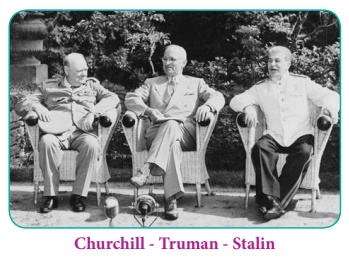
Otherwise there was no peace conference. Great
Britain, the Soviet Union and the US, represented by Churchill, Stalin and
Truman, agreed at the Potsdam meet to create a council of foreign ministers of
five Powers – the Big three plus China and France – to continue the necessary
preparatory work for the peace settlements. This council became the principal
agency for peace-making in Europe. It was agreed upon that peace treaties with
Italy, Hungary, Belgium, and Rumania be finalised before dealing treaties with
Italy and Germany. Great Britain, USA, USSR and France would draft the Italian
treaty, the Big three would draft the three Balkan treaties, Great Britain and
Soviet Union would draft for Finland. Then the draft treaties would be
considered at a general conference.
Peace Conference, 1946
1500 delegates from 21 nations met at Luxemburg Palace,
Paris, from July 26 to 15 October 1946. After a great deal of deliberations the
recommendations of the conference were reviewed by the Council of Foreign
Ministers and adopted after slight modifications.
Italian
Peace treaty: The issue of Trieste dragged for several years. Italy demanded Trieste. Soviet Union
had promised it to Yugoslavia. Finally, in 1954, Trieste was divided into Zone
A and Zone B. Zone A went to Italy, while Zone B was awarded to Yugoslavia. The
Italian reparation was fixed at $ 260,000,000 (most of it to go to Greece and
Yugoslavia).
Reparation
to Russia: Hungary, Belgium and Finland were to give $100,000,000 to Russia. Bulgaria was to
pay $25,000,000 to Yugoslavia and $4,000,000 to Greece. Rumania agreed to give
back Bessarabia, acquired in 1919, and Bukovina to Russia. The Belgium treaties
guaranteed the free navigation of the Danube. But it was blocked by Russia. The
treaties came into effect from 15 September 1947. But the provisions were
either violated or ignored.
Austria: Disputes
arose over the claim of Yugoslavia
to a portion of Austrian territory in southern Carinthia. Yugoslavia also
demanded $150,000,000 as reparation. The problematic issue of defining German
assets could not be resolved even though the commission set up for this purpose
met in 85 sessions. The issue of reparation with Russia was settled with the
Soviet extension of rights to the oil and shipping facilities in Austria and a
cash payment of $150,000,000 over a six year period in lieu of the German assets.
Austria was reestablished as a sovereign, independent and democratic state with
the same frontiers it had before the forced union with Germany in 1938. Austria
agreed not to enter into political or economic union with Germany in any form.
Germany: The conference
held at Potsdam, near Berlin, issued
the following formal declarations: 1. East Prussia to be divided into two
parts: northern part going to the Soviet Union, and the southern part to
Poland. 2. Poland to receive the former free city of Danzig. The military power
of Germany was to be totally destroyed, and Germany was to be divided into four
occupation zones to be governed by the USSR, Great Britain, the United States
and France. Thus substantial portions of pre-war Germany were transferred to
the USSR and to Poland. Berlin in the heart of Russian sphere and the rest of
the country was divided into four zones. In April 1949 the German Democratic
Republic was proclaimed in the Soviet zone. NATO decided to approve the Federal
Republic of Germany. In September the newly elected parliament of the Federal
Republic of Germany was established.
Poland
Poland moved some 200 miles to the west, losing
about 69,000 sq.miles to the Soviet Union and gaining slightly less from
Germany in the west. Poland would surrender its eastern provinces to Russia and
the existing government of Poland, setup under Soviet aegis, was to be
reorganised with the inclusion of democratic leaders from among the Poles.
Japan
Roosevelt, Churchill and Nationalist China’s
Generalissimo Chiang Kai-shek met in Cairo as early as in November 1943 and
decided the fate of the Japanese empire. All the territories taken by Japan
from China, with the exception of Korea, were to be restored to the Chinese
Republic. Korea was to become free and independent. Japan lost all conquests it
had made since 1931. It was also obliged to give up Formosa (now Taiwan) and
the Pacific islands that it had gained decades earlier.

After meeting in a conference at Yalta, in the
Crimea (February 1945), Roosevelt, Churchill and Stalin declared their plans
for the unconditional surrender of Germany, upon methods of controlling Germany
and her allies after the war, and upon the establishment of United Nations
Organisation to preserve the peace, the economic organisations, known
collectively as the Bretton Woods system, the World Bank, the International
Monetary Fund and the General Agreement on Trade and Tariffs to achieve
post-War reconstruction of the economies which had been devastated by the War. Unlike
after the First World War, this time, Roosevelt was determined that the United
States should join the world peace organisation.
Results of the Second World War
The Second World War caused unprecedented hardship.
As many as 60 million died, and great cities such as Warsaw, Kiev, Tokyo and
Berlin were reduced to rubble. The majority of ports in Europe and many in Asia
were destroyed or badly damaged; bridges were blown up; railway locomotives and
rolling stock vanished. Millions of people lost their homes. Germany ceased to
be a great power. Europe lost its status and prestige. The economy was in a
shambles. It was clear that the two dominating powers in the world were the
United States and Soviet Russia. The ideological divisions between the two made
the post -war cooperation impossible, as we shall see in the next lesson.
Great Britain emerged with enormous prestige, but
her position as a world power diminished on account of reduced wealth, and the
shrinking of its empire. The Second World War was fatal to many European
monarchies. Kingship was abolished in Rumania, Yugoslavia, Bulgaria and Italy.
Apart from Britain, it survived only in Denmark, Norway, Sweden, Holland and
Belgium and that too only as constitutional monarchies.
The world had been one in its effort to defeat
fascism which had threatened world peace. The Allied victory had been
underpinned by the popular support for the war effort. The struggle against
fascism also empowered the common people. The shared suffering and sacrifice of
the war years strengthened the belief in most democracies that governments had
an obligation to provide basic care for all citizens. When it was elected in
the summer of 1945, for example, the Labour government in Britain moved rapidly
to establish a welfare state. It became the government’s obligation in Britain
to provide insurance against accident, sickness, old age and unemployment. The
rights of women also took a huge step forward as their contribution to the war
effort, and their share in the suffering, were recognised. In France and Italy,
women finally got the vote.
The most significant outcome of the War was the
transformation that had taken place in colonies. The fight for democracy
encouraged the nationalist forces to intensify their liberations struggles. The
defeat of armed forces of the Western countries by Japan in Southeast Asia and
also the initial setback suffered by Britain and France in the War at the hands
of Germans sent a clear signal that white men and their states could be
defeated. The old empires also realised that the Age of Empire was definitely
at the end. The Dutch, for instance, found it difficult to maintain adequate
military forces in the huge Indonesia archipelago. In Indo-China the French,
supported by the British and later by the USA, made a desperate attempt to hold
back its independence. But the French were defeated and forced to withdraw in
1954. The attempt by Britain and France to reassert themselves as global
imperial powers in the Suez Crisis of 1956 was doomed. Later the US war against
Vietnam turned out to be a shameful failure.
Related Topics